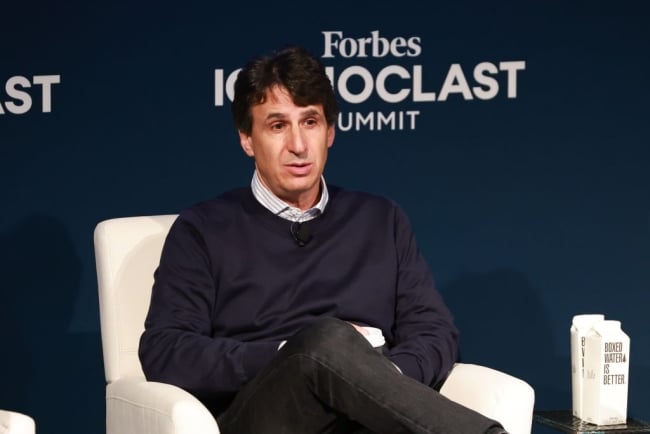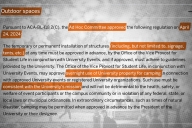You have /5 articles left.
Sign up for a free account or log in.

Marc Rowan, CEO of Apollo Global Management, led fellow alumni and other billionaires in a campaign to withhold donations from the University of Pennsylvania over concerns about antisemitism.
Arturo Holmes/Staff/Getty Images Entertainment/Getty Images North America
Higher education is experiencing pressures from within and outside its walls. One such pressure is the perception of the increasing influence of donors and alumni on institutional policies and values. This has been on display with recent actions by donors who have objected to the ways universities have responded to the Hamas-Israel war.
The most prominent examples involve billionaires withholding funds, or implicitly or explicitly threatening to withhold them, from Ivy League institutions. Harvard University faced a rupture with the Wexner Foundation, which in cutting ties with the Kennedy School cited the Harvard leadership’s failure to condemn the Oct. 7 attacks on innocent Israelis by terrorists. Citadel CEO Ken Griffin, a Harvard alumnus who has given the university more than $500 million, did not publicly withdraw his financial support, but he did urge Harvard to take a clear stance against student groups that supported Hamas and blamed Israel for the terror attacks.
At the University of Pennsylvania, Apollo Global Management CEO Marc Rowan led fellow alumni and other billionaires, including Ronald Lauder, and former Utah governor and U.S. ambassador Jon Huntsman Jr. in closing their checkbooks or “re-examin[ing]” their financial support over the handling of antisemitism and the response to Hamas’s attacks.
The withholding of funds has sparked debates, with some characterizing this action as a threat to academic institutions by labeling it “donor control.” These critiques are meant to delegitimize the donors’ actions by invoking higher education’s “third rail,” academic freedom. More than 120 Harvard faculty members signed an open letter to President Claudine Gay arguing that her steps to combat antisemitism in response to pressure from donors and others jeopardized the “university’s commitment to intellectual freedom and open dialogue.”
At the University of Pennsylvania, the Faculty Senate tri-chairs issued a statement in which they argued that their values “are being threatened by individuals outside of the university who are surveilling both faculty and students in an effort to intimidate them and inhibit their academic freedom.” They continued that academic freedom “is not a commodity that can be bought or sold by those who seek to use their pocketbooks to shape our mission.” By positioning alumni and donors as “individuals outside of the university,” the Faculty Senate tri-chairs are severing the university community and redefining the long connections between graduates and their alma mater.
While academic freedom is essential to academe, I argue that this recent wave of donor action is similar to other forms of activism we have seen on campuses over the years. Further, I contend that given the sociodemographics of many of the alumni and donors—Zionists and Jews—who are involved, the use of the label of monetary control invokes antisemitic tropes. In fact, in New York City, pro-Palestinian protesters are less subtle, hanging stickers that say, “ZIONIST DONORS AND TRUSTEES, HANDS OFF OUR UNIVERSITIES,” with the “OUR” emphasized in larger lettering.
I believe that these donor actions are not instances of donor control but rather are a form of donor activism that is in line with higher education’s mission. American higher education has a multifaceted mission, encompassing academic excellence, knowledge pursuit and the development of ethical, engaged citizens. The concept of lifelong engaged citizenship extends beyond formal education, emphasizing continuous learning, active civic participation and contributions to communities.
A nuanced examination reveals that donors and alumni, in their activism, could be driven by a genuine desire to remain actively involved in the universities they attended, shaping institutional values and contributing to the broader educational landscape: through donor activism, alumni are enacting the mission of higher education by pushing institutions to espouse their values and commitments to societal betterment. The Wexner Foundation, in its letter, wrote that the decision to withhold funds reflected the fact that “our core values and those of Harvard no longer align.”
Similarly, in his letter, Jon Huntsman Jr. wrote to Penn’s now former president that his alma mater was “almost unrecognizable” for what he described as its “moral relativism” and “silence in the face of reprehensible and historic Hamas evil against the people of Israel.” Huntsman added, “Silence is antisemitism, and antisemitism is hate, the very thing higher ed was built to obviate.”
While there is a focus on the mega-wealthy, smaller-scale donors are protesting with their philanthropy as well. The Harvard College Jewish Alumni Association initiated a campaign advocating for a cap on annual donations at $1. In their open letter, they stated, “Harvard has changed in ways that have made it unrecognizable to us. When living up to its ideals, Harvard fosters healthy disagreement but demands decency. It’s a place deeply imbued with a sense of moral purpose. But Harvard’s response to the Hamas terrorist attacks of October 7th revealed that the university has lost its way.”
Viewing the decision by large- and small-scale donors to withhold funds as donor activism reframes the narrative. Donor activism, a form of social movement, involves using financial resources to support causes aligned with values, aiming to influence societal (and campus) change. Applying a social movement lens highlights parallels with other forms of collective action in higher education, such as student protests. Just as students express their concerns and aspirations through protests and activism, donors and alumni exercise their influence to shape the trajectory of the universities they attended. In both instances, donors and students leverage their influence to advocate for their visions of an institution’s future, emphasizing a shared commitment to advancing the public good. Though power dynamics may vary, these actions underscore a collective dedication to shaping the direction and societal contributions of higher education.
A person’s social identity plays a pivotal role in their philanthropy and their activism, serving as a foundation for collective action and change. Activism often emerges from shared identities, whether rooted in race, gender, religion, sexual orientation or other social constructs. Individuals unite around common experiences and aspirations, forming a collective identity that fuels their commitment to addressing systemic issues. As activists strive to dismantle inequalities and advocate for justice, the power of social identity becomes a driving force, binding people together in the pursuit of a more equitable and inclusive society.
The use of philanthropy as part of a social movement is not a new phenomenon. In the aftermath of George Floyd’s murder in May 2020, a notable surge in donor activism within the antiracism movement became evident. Contributions surged to new organizations such as the George Floyd Global Memorial and the Black Lives Matter Global Network Foundation, as well as established organizations like the NAACP, the American Civil Liberties Union and the Equal Justice Initiative.
In higher education, donors began to support the creation of or increased funding for diversity, equity and inclusion initiatives; historically Black colleges and universities; and centers for antiracism in the hopes of bringing about lasting societal change. These instances underscored how donor activism became a crucial vehicle for channeling resources and catalyzing positive transformations in the fight against systemic racism.
Arguably, today we are seeing the emergence of a new social movement with the coalescing of Jewish donors and their allies around their shared religious, ethnic and cultural identity in order to combat increased antisemitism on college campuses and in support of Jewish self-determination. While many donors are choosing to withhold funds, some are investing in higher education to create spaces to study and combat antisemitism, akin to the donor activism seen around antiracism. See for example, the recent announcement at New York University of the new donor-funded Center for the Study of Antisemitism.
Ultimately, this current form of donor activism should be seen as a form of engaged citizenship, reinforcing the idea that the university community, comprised of alumni, donors, faculty, administrators and students, collectively contributes to the public good. By fostering open dialogue, transparent decision-making processes and a shared commitment to educational values, higher education institutions can harness the positive aspects of donor activism while safeguarding the principles of academic freedom.








